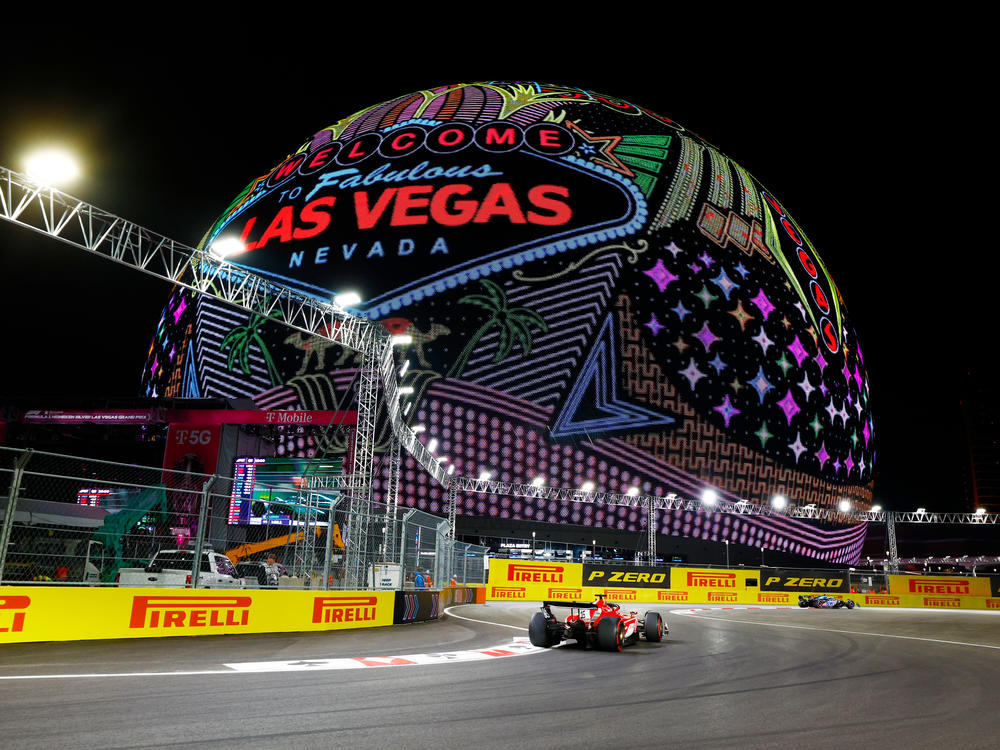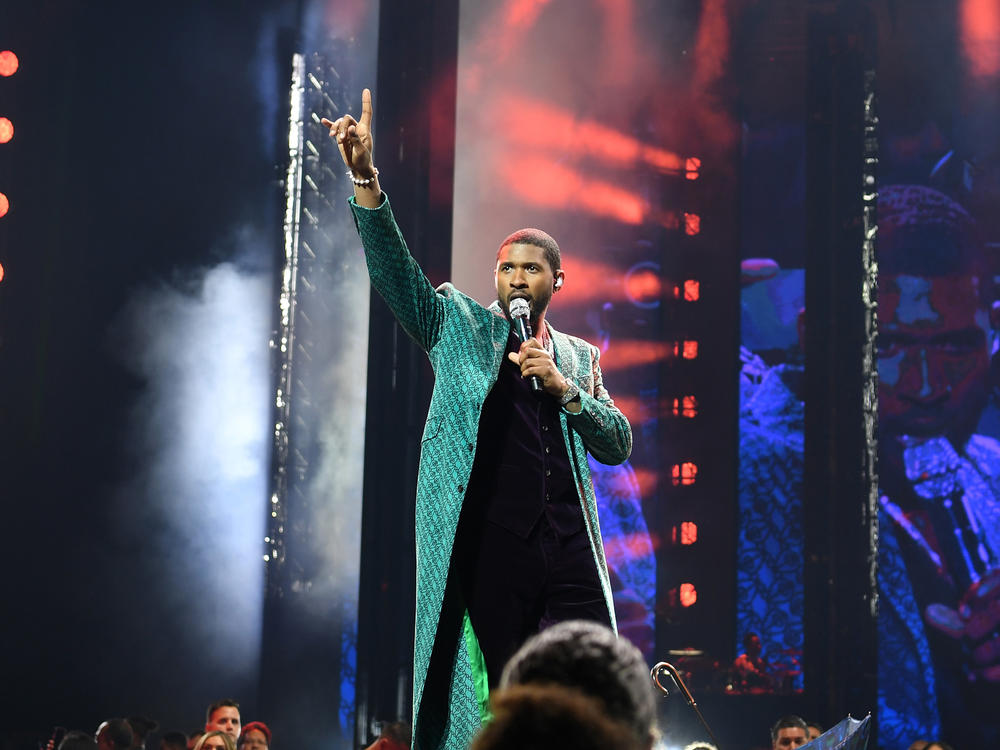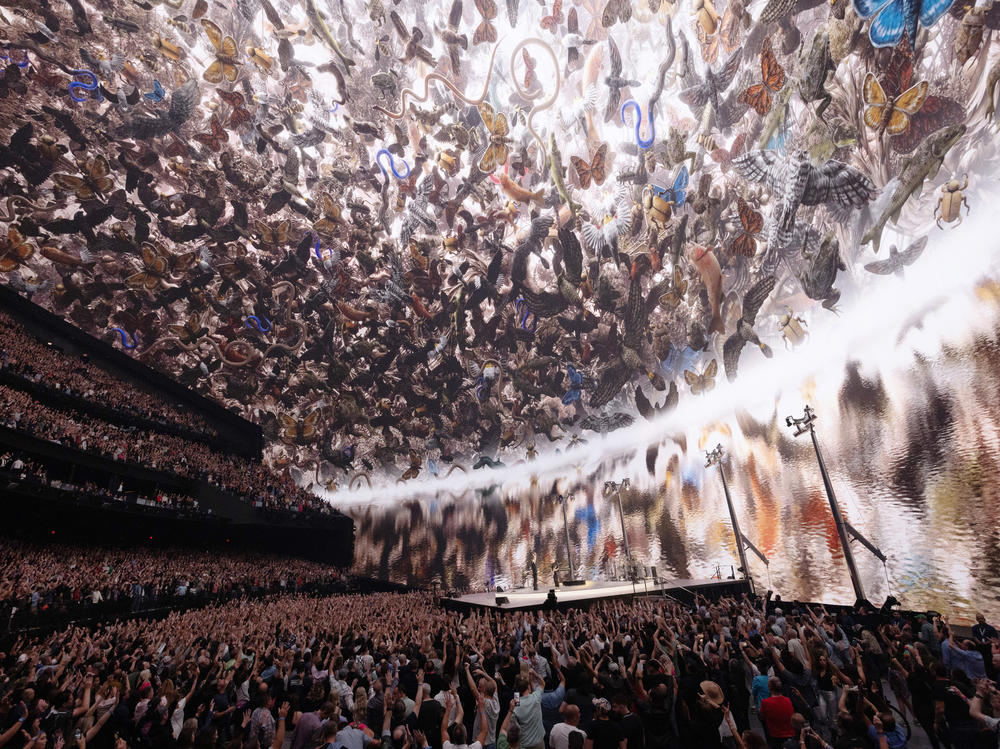Section Branding
Header Content
How the pandemic ushered in a maximalist new era for Las Vegas residencies
Primary Content
When Usher performs on Sunday evening in Las Vegas' Allegiant Stadium during the city's very first Super Bowl, he'll also be graduating from two years as one of its busiest and most successful working residents. In the post-pandemic market for maximalist entertainment — an insatiable experience economy fueled by revenge travel and irrational spending — America's "capital of entertainment" has found itself at the center of a cultural revival. Usher's concert residencies at both Caesars Palace and the MGM Grand have been critical, commercial and Instagram blockbusters.
Alongside his triumphant tenure on the Strip, Adele is now in the third sold-out stretch of her revue at The Colosseum at Caesars Palace, and, as of last fall, U2 has landed in a monumental new concert hall made almost entirely of screens, the Sphere. Professional sports teams, Formula 1 races, futurist design hotels and entire new districts have joined the world's most technologically advanced concert venues to create a new kind of dazzle in Las Vegas, far removed from my own assumptions and once biased antipathy.
Las Vegas has had its cultural eras, and most of them are neither remembered nor represented fondly — Liberace, Rat Packs and mob wives, Elvis, Hunter S. Thompson's Fear and Loathing come to mind. As a child of the '90s in Virginia, the city was revealed to me as a cinematic and spiritual hellscape via cable TV — Scorsese's Casino, Nicolas Cage in Leaving Las Vegas, the underrated Saved by the Bell shotgun wedding movie and, on that note, Elizabeth Berkley in Showgirls. But vintage fictions have not kept pace with modern reality. When I moved to Los Angeles in 2022, I finally decided to drive across the Mojave to the maniacal mirage in the desert. For an economy premised on tourism, updating the cultural environment to attract a new generation of customers feels relentless. Entire resorts have been torn down, entire neighborhoods created at great pains to local residents. A high speed train to Los Angeles is in the works, inaugurated by train-loving President Biden, all in the service of serving and courting a new generation of younger, browner and wealthier spenders. For better and certainly worse — chicken or egg — as capital flows, culture follows.
The trinity of Usher, Adele and U2 signed on to become the city's marquee post-COVID-19 attractions just as an unprecedented appetite for live performance was unleashed nationwide. As Taylor Swift and Beyoncé took their economy-shaking spectacles on the road in #BillionGirlSummer, the lavish production design and luster of Vegas created an analogous live renaissance in one concentrated location.
Celine Dion inaugurated this new era for performance in Las Vegas with her aptly titled "...New Day" residency in 2003 at Caesars Palace. Over more than 15 years, she performed more than 1,100 shows in a colosseum constructed specifically for her heart to go on (and on). With sequined suits and classy choreography, Dion reinvented the possibilities of the Vegas revue. Other mass entertainers, mostly women, including Britney Spears, Jennifer Lopez, Mariah Carey and Lady Gaga followed. As mega DJs like Calvin Harris joined Spears & Co. in the parade of millennial pop stars, an unironic play for younger visitors became a strategic imperative.
After decades of attracting a mostly white, older and middle-income gambling audience who may have added a Siegfried & Roy or an acrobatic show as an addendum, the profile and priorities of Vegas' hospitality industrial complex has shifted in recent years. According to the city's own 2022 Visitor Profile study, the average age of the Vegas visitor is now 40.7 down from 44.3 in 2017, and 54.3 in 2002. The average spending on entertainment has more than doubled, to $309.76 in 2022, from a decade earlier. Deeper in the archives shows that two decades ago, only 5% of surveyed visitors to Las Vegas were non-white, and that number has now grown to almost 40%.
I fall into this target audience, at first curious as to why Adele would choose a casino at the peak of her powers to stage her return to performance. Having seen Adele on each of her previous tours, "Weekends with Adele" is absolutely her best and most befitting presentation. It has been a rehabilitation for her, as an artist, and she has credited it with restoring faith in herself, as a live performer. The show, which was canceled and re-designed at the last minute, is a gorgeously designed and delivered spectacle, as I wrote in my review for NPR, a production merging her gift of gab with vocal pyrotechnics that spans her entire discography. Also, because it is in Las Vegas, there is also the setting of fire to the rain and pianos aflame. Last week, she announced a one-off set of concerts in Munich — her first in Europe in eight years — in a new temporary stadium that evokes the design of her Vegas residency.
Usher was the first major artist to announce a post-pandemic concert series in the city in 2021. It was not a career in decline, per se, but without an album cycle in almost a decade, it could have easily been a nostalgic replay for the 45-year-old former R&B wunderkind. Instead, "My Way" — the title of its second iteration that concluded last December — transformed MGM's Dolby Atmos-equipped live theater into an exhilarating showcase for Usher's enduring vocal and physical prowess. Performing on an immersive set that brought Atlanta strip clubs to a Broadway scale, an often shirtless Usher and his dancers cruised through the set list, frequently on roller skates, dancing with the likes of Keke Palmer, Issa Rae and Janelle Monáe rendered breathless in the audience.
The predominantly Black crowd was the definition of "grown and sexy" — dressed impeccably, with many groups of girlfriends enjoying Usher's devotion to the female gaze. Kim Kardashian even dedicated an episode of her reality show to her attendance. Without a new album cycle, Usher became the subject of hagiographic profiles, leading The New York Times Magazine to ask "Can Usher Turn America On Again (to R.&B.)?" It was the creative success and luster of the residency that led to this weekend's Super Bowl stage and to his first new album in eight years, Coming Home, and plans for a national arena tour. As Usher told Good Morning America last week, Black performers were once forced to enter and exit Las Vegas stages through kitchens and back doors, and he was now proudly restoring R&B to its very center as an adopted hometown icon.
But nothing speaks to the revamped maximalism of Las Vegas more than the Sphere. British designer and artist Es Devlin, who has created touring stage designs for Beyoncé, The Weeknd and Kanye West, among others, was involved in designing visuals for U2's current show. She told me that, unlike most arenas and stadiums designed for sport that must be temporarily outfitted for performance, this is the first purpose-built mass pop concert venue where speakers and screen are merged into one seamless skin. The screen that envelopes the arena of 20,000 has no borders or dimensions, it becomes both sky and walls, creating a minimal sight line to offer maximum immersion — or subjugation, depending on your point of view.
U2 had already been planning an anniversary tour for the 30th anniversary of Achtung Baby in 2021, but as early tech adopters and forever maximalists, they've said they were drawn to Las Vegas by the venue's possibilities. In my experience, the show is drawing an older, whiter and certainly more male audience, but many that are also simply technologically curious. Even as someone who did not know Achtung Baby verse to verse as my neighbors did, the sonic fidelity of its many layers and the monumental images designed to accompany them were awe-inspiring. That said, U2 is simply warming up the Sphere. A superfan near me commented that, even though it's his seventh time at "U2:UV" already (madness), a pop star with a more visual and grandiose imagination could blow this space apart, proverbially speaking. Coldplay, Beyoncé, Dua Lipa, Megan Thee Stallion could be candidates. As we walked out in awe, my partner suggested that while it may sound hyperbolic, could we have just been inside The Palais Garnier or Sydney Opera House for the Spotify and Instagram Live era? Based on the show we saw and what is clearly possible within, that thought no longer seems unreasonable. The Sphere is designed to be filmed, become film and submerge those of us already accustomed to life mediated by screens in a sky of digital artifice.
Meanwhile, the residency offerings to come this season continue, with Christina Aguilera, Kylie Minogue, Ludacris, Wu-Tang Clan, Bruno Mars and Kelly Clarkson. With soaring ticket prices often starting at $400 and umpteen forms of VIP packages into thousands at face value, the purpose is still timelessly Las Vegas — explicitly and unapologetically commercial. NPR Music contributor and scholar Jason King, Dean of the University of Southern California's School of Music, told me that Vegas residencies "almost exist outside critical infrastructure. These are blockbuster celebrities doing a blockbuster show for a mass audience in a city with a reputation for brands and brand building." With fandom in such a time of commercial and attention devotion, the Vegas performance, with its plush surroundings and eventism, becomes a rarefied commodity. What does not hold true in this new era, however, is my own notion of washed-up and has-been artists serving audiences with atrophied tastes in a sad crumbling theme park of neon. Whether it's rock, R&B or Adele's balladry, artists with urgent and undeniable gifts are coming to Las Vegas not to age into the cozy domesticity or the mummification of residencies, but to be creatively nourished and reborn through them.
Las Vegas may have once epitomized a kind of bleary, burdened and tragic fate in my own mind, full of hangovers, loneliness, betrayal and the suspension of time. A place where America's worst impulses collide and nothing remotely resembling art, or that most complicated of ideas — beauty — is created. But how to reconcile that metanarrative, held especially close by East Coast notions of cultural and intellectual superiority, with the creative coherence, exuberance and aliveness of what is now occurring on its pop stages? It's a reality bound to electrify this weekend, led by a R&B singer who will now be the Vegas icon I'll associate with the city — not Liberace, Sinatra, Osmond or even Dion, but one Usher Raymond IV. As he sings on the title track of his last studio album, "... they call me Las Vegas. You get what you paid for."




